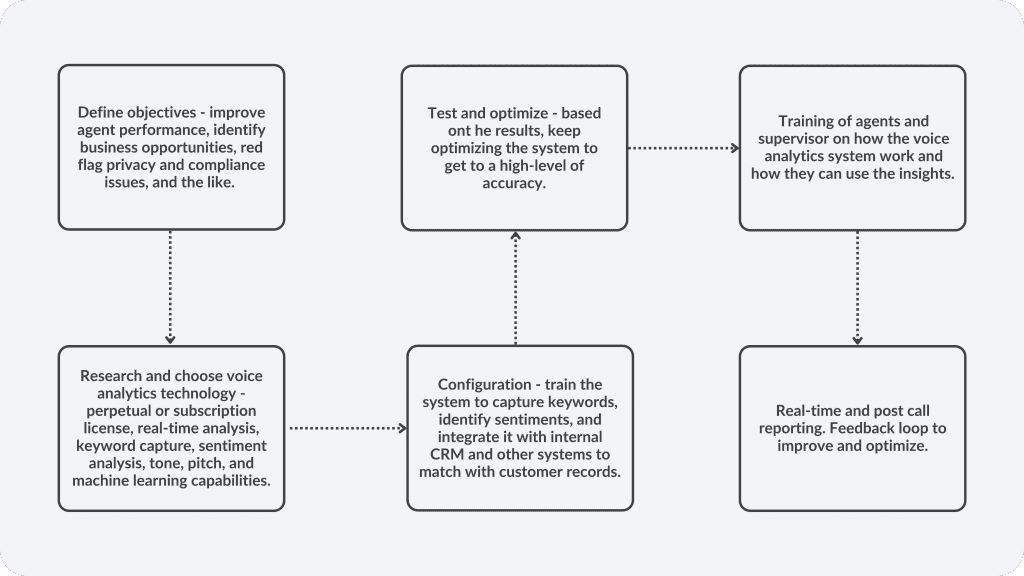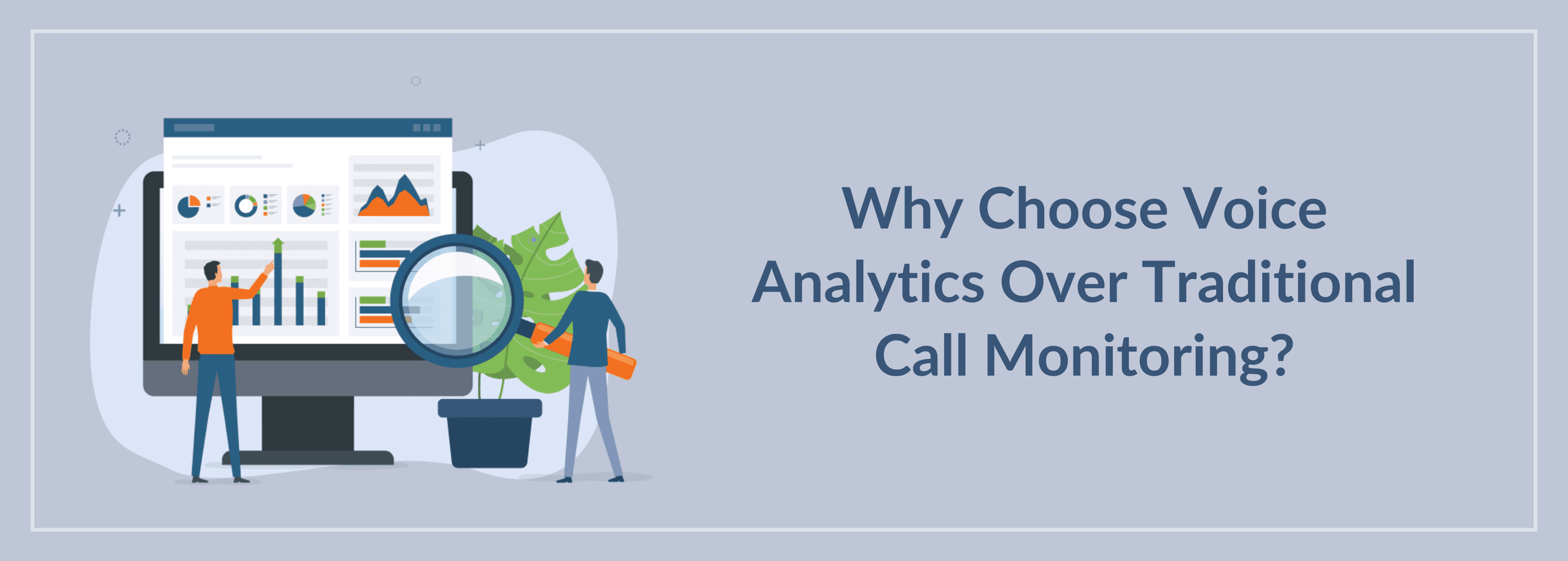Why Should You Choose Voice Analytics Over Traditional Call Monitoring?
According to a Qualtrics study, 63% of consumers believe companies need to get better at listening to their feedback. Besides, over a third of the consumers are dissatisfied with the empathy shown in their customer service interactions.
How Do You Improve Customer Relationships and Customer Interactions?
As an organization, you need to monitor your calls to understand the quality of your calls.
Call monitoring is the evaluation of conversations between your call center agents and customers. It helps in understanding the quality of the call and the agent’s performance, besides letting you identify the friction points, compliance needs, and training needs of your agents.
Call monitoring is not something new – it has been in existence for ages. With the amount of call data that is generated today, traditional call monitoring methods are becoming ineffective, and you need automation and analytics to make sense of them.
To understand the depth of what we are talking about, let us consider this scenario:
Each minute of a call generates 120–150 words. With 200 agents averaging 4 hours of talk time daily, your contact center produces terabytes of data.
But how do you monitor it all?
In reality, only 2% of calls are reviewed—98% remain untouched unless there’s an issue. This means valuable insights are often overlooked, costing organizations significantly.
Let’s quickly look at how traditional call monitoring worked
What Is Traditional Call Monitoring?
In Traditional call monitoring, supervisors and quality assurance analysts spend time going through call recordings and live calls to ensure compliance, assess agent’s performance, and identify areas where performance can be improved.
This was done manually, and it is a humungous task. Supervisors can only listen to a limited number of calls, which may force them to overlook critical issues. While supervisors were able to provide real-time feedback to agents, it was few and far, and inefficiency was built into the process itself.
This is where contact center voice analytics software can help an organization make sense of its call data and provide actionable insights.
Voice Analysis – How Is It Helpful in a Call Center?
With Voice Analysis, you can rapidly analyze call recordings to identify compliance issues, misselling, and privacy issues – either warn the agent or escalate to a manager to take corrective action.
This would ensure that your call center is compliant with regulations and helps you understand grey areas to improve your call center’s overall productivity and happiness.
Let us look at some use cases to appreciate the effect of voice analysis:
1. Appointment Booking
A healthcare facility’s call center received enormous calls to book appointments to meet doctors in their facility. The call center was happy to help their patients with it. But, when the healthcare facility analyzed its call recordings, almost all the patients mentioned that they visited their website, had trouble booking appointments, and had to reach out to the call center.
This was an insight they wouldn’t have had automatically from their call recordings without a voice analytics software So, the healthcare facility has tweaked the book appointments feature on its website, which has started working well.
Now, the number of appointments hasn’t come down, but the number of patients reaching out to the call center to book appointments has come down.
2. Compliance Issues
Insurance selling is a regulated industry, and you will have to make sure that the customer understands all the required disclosures during the sale. Besides, you can’t incentivize a customer during the insurance purchase.
One of the insurance firms was reaching out to many prospects, but the sale closures turned invalid. When the voice analytics platform assessed the recordings, it glaringly revealed that the sales reps were not reading the required disclosures during the sale. This is a red flag in the process, and the sale loop wasn’t closed.
It also allowed the insurance firm to figure out the specific reps who weren’t doing this and helped create a training plan for those agents.
Check this blog on : Voice analytic in BFSI industry
3. Identifying Self-Service Options
When the pandemic struck, the call volumes at a bank’s call center went up drastically. They were moving their agents to work from home, and the call volumes were increasing. So, the time they took to resolve customer queries went up, which made their customers unhappy.
They decided to automate their processes to handle their customer queries better. There wasn’t any consensus on what could be automated. Voice analysis of their calls revealed the commonly asked straightforward transactional queries, and they took those up for their first level of implementation.
This helped the bank set up self-service tools on their digital platforms. It brought down the number of calls that the call center was receiving, and it helped in addressing their customer queries faster and better.
How Does a Voice Analysis Solution Work?
Voice analysis uses audio from recorded calls and converts them into structured data for searching and analyzing. The tools also utilize other associated data, such as customer profile information or when the customer interaction occurred. A text transcript is also extracted from the call.
Its features include advanced search and filtering, enterprise-grade speech recognition and transcription, contextual call playback data, tagging and commenting, transcript visualization, and full PCI redaction.
The search works in a custom fashion. It includes a highly flexible search engine for quickly and easily finding and retrieving calls through a free-form combination of keywords, phrases, acoustic measures, filler words, and call metadata.
Why Is Voice Analysis Gaining So Much Ground?
Voice is the primary form of communication in a call center. With customer experience becoming the key competitive differentiator, every organization stands to gain from the voice interactions that customers have with their agents. There are a whole bunch of learnings that can come from voice.
For instance, the agent may not be aware of the growing ire of the customer, but the computer recording the call would. It can even analyze if a customer is irritated, stressed, or plain disappointed with the interaction that they had with your organization.
Using big data techniques combined with voice analysis, an organization can get important business insights by analyzing a huge volume of call data.
What Are the Differences Between Traditional Call Monitoring and Voice Analytics?
| Feature | Traditional call monitoring | Voice analytics |
| Technology | It is a manual process where supervisors and quality assurance analysts manually listen to the calls and review them. | Use advanced technologies like speech recognition, natural language processing, and machine learning to listen and analyze the calls. |
| Data volumes | Restricted to a small set – probably less than 10% of the calls as it is done manually. | Analyze any volume of calls automatically and in real time. |
| Scope of analysis | Focuses on the content and often overlook the emotional cues. | Evaluates not just the words but emotional cues like tone, pitch, pace, pauses, and filler words. |
| Accuracy | It is not so accurate as it is prone to biases and subjective interpretations. | It is more scientific and objective, and it eliminates human biases. |
| Scalability | It is limited by the number of analysts and supervisors the organization has for call monitoring. | It can scale to review 100% of the calls, as it is automated. It is suitable for high-volume call centers. |
| Insights | They are often anecdotal and depend on the experience of the individuals and the limited calls analyzed. | It helps identify systemic issues and provides detailed reports, trends, and patterns across the entire call volume. It is ideal for flagging compliance issues, misselling, privacy, and training needs. |
| Feedback loop | It is often delayed, and it has to wait until after the call review. | It allows real-time feedback, triggering alerts during or just after the calls. |
| Costs | Requires significant resources for manual call review, making it more expensive in the mid-term to long-term. | While the initial setup or subscription costs might be there, it reduces labor costs, and the level of insights you get ensures faster ROI. |
While we discussed the differences between voice analytics and traditional call monitoring, most call centers are moving away from the manual process, except perhaps the small ones whose call volumes are not very high.
How Do You Implement Voice Analysis in a Call Center?

The future of voice analysis looks promising, and it will ensure that organizations offer exceptional customer experiences.
With the increased use of AI and ML, voice analysis will be able to generate real-time insights in the ‘here and now’ that organizations can effectively use to enhance their customer service and offerings.
Besides, you will have hyper-personalization and omnichannel insights (combining voice, text, and imagery) that would allow organizations to serve their customers better.
Check our article on : Use Cases of Voice Analytics in a Contact Center
In summary, it is not appropriate to compare voice analytics with traditional call monitoring in terms of what it can deliver and how organizations can make use of it.
Unless you are a small operation, you should consider using voice analysis as a part of your call center platform. The benefits far outweigh the cost and the efforts it takes to integrate voice analytics as a part of your infrastructure.
How often have you thought about how you can make sense of all the customer conversations in your call center?
Well, the wait is over.
Embrace voice analysis, and you will never regret the decision.
